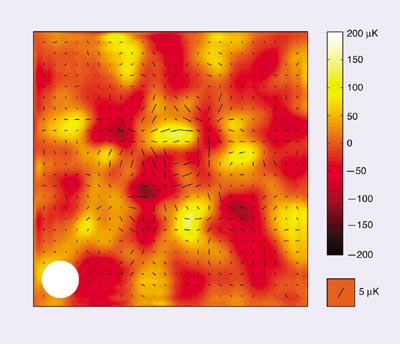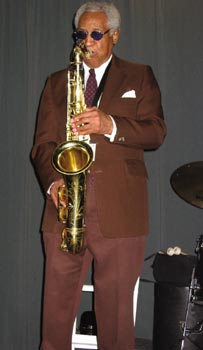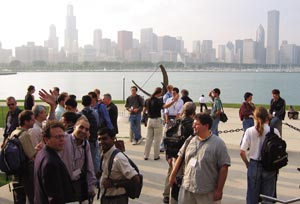Christian Armendáriz-Picón and Géraldine Servant report from the sixth conference in the COSMO series.

Last September, the 265 seats of Chicago’s Adler Planetarium, on the Lake Michigan shoreline, were filled with participants at the COSMO-02 International Workshop on Particle Physics and the Early Universe. The conference was co-organized by the Center for Cosmological Physics at the University of Chicago, the Adler Planetarium and the Theoretical Astrophysics Group at Fermi National Accelerator Laboratory. COSMO conferences provide a forum for particle physicists, cosmologists and astrophysicists to discuss new results in the exciting and fast-moving field of particle astrophysics and cosmology. One of the new features this year was the presence of string theorists, showing that the latest cosmological observations have attracted the attention of a very large and diverse physics community.
The conference opened with a talk by Wendy Freedman of Carnegie, who addressed the recent emergence of a “standard model” in cosmology. From an observational point of view, our universe can be described by only a few parameters, such as the Hubble “constant” and the contribution of the different constituents of the universe to the total energy density. As Robert Kirshner of Harvard, David Weinberg of Ohio and Tim McKay of Michigan pointed out, a combination of the results of different cosmological observations already allows us to measure those parameters with unprecedented accuracy (by cosmological standards). Moreover, ongoing or planned projects, such as large-scale structure catalogues (2dF, SDSS), cosmic microwave background maps (MAP, Planck) and supernova surveys (ESSENCE, SNAP) will soon allow further significant reductions in the error bars. These precision measurements will help us to refine our understanding of the universe, and will certainly shed light on what is currently the most challenging puzzle for cosmologists and particle physicists – the nature of dark energy. This is currently the dominant energy component of the universe that causes its expansion to accelerate.

On the theoretical side, the standard model of cosmology rests on two pillars: cold dark matter (CDM) and inflation. In a CDM cosmology, most of the matter of the universe consists of non-baryonic, non-relativistic and collisionless particles. Numerical simulations show that the gravitational attraction between these particles yields structures – galaxies, clusters and superclusters – that agree with the ones observed in the universe, possibly up to certain discrepancies at subgalactic scales. The potential problems of the CDM scenario and the properties of some alternative scenarios, such as self-interacting dark matter or modified Newtonian dynamics, were critically discussed by Marc Kamionkowski of Caltech and Arthur Kosowsky of Rutgers. At this stage it is still disputed whether the CDM scenario is free of problems, but as the talk by Andreas Albrecht of Davis suggested, it is fair to say that theorists continue to be in the dark regarding dark energy.
Inflation goes on and on
Inflation remains one of the cornerstones of modern cosmology. According to the inflationary paradigm, the early universe experienced a stage of accelerated expansion. As a result of this expansion, inflation produces a homogeneous and flat universe, as confirmed by cosmic microwave background (CMB) measurements. Inflation also explains the origin of the tiny primordial density fluctuations that developed into galaxies and clusters by gravitational instability. David Wands of Portsmouth described how inflation relates these primordial density perturbations to quantum fluctuations of the scalar field that drives inflation. Despite the fact that there is no theoretically preferred inflationary scenario, most inflationary models make definite predictions about the properties of these primordial density perturbations. They should be Gaussian, adiabatic and nearly scale-invariant. These predictions have been confirmed in an impressive series of experiments, and as Lloyd Knox of Davis reported, new CMB missions, such as the MAP and Planck satellites, will further test, scrutinize and constrain inflationary models.
Essentially the same mechanism that explains the origin of primordial density perturbations – quantum fluctuations of the inflation field – seems to imply that inflation will be eternal. As discussed by Alan Guth of MIT, who also delivered a widely attended public lecture at the Adler Planetarium, an inflating universe resembles a fractal. In a given inflating region of the universe, inflation has a finite lifetime, but at any given moment of time, there are always patches of the universe that continue to inflate. It is unclear whether such a prediction can be experimentally tested, but it certainly poses dramatic views on the global structure of the universe.

An important confirmation that our theoretical understanding about CMB fluctuations is on the right track came with the announcement by John Carlstrom of Chicago of the first measurement of CMB polarization by the DASI experiment. According to the standard theory, the temperature anisotropies we observe in the CMB are due to acoustic oscillations of the primordial baryon-radiation plasma. If this is true, the light that last scattered at the time of recombination – i.e. the CMB – should be partially polarized. The measurement of such polarization is a success of the standard theory, and represents the first step towards more ambitious measurements of the properties of the CMB polarization. As Alessandra Buonanno of Paris pointed out, the sea of relic gravitational waves that inflation predicts should leave a characteristic imprint on the polarization pattern of the CMB. This imprint could be used to determine the amplitude of gravitational waves produced during inflation, which in turn fixes the energy scale at which inflation took place.
Because of the high-energy scale at which inflation is expected to take place (around 1015 GeV in the simplest models), the primordial perturbations generated during inflation might be our only hope of probing the physics close to the Planck scale. This possibility was explored in a plenary talk by Nemanja Kaloper of Davis. Although in some inflationary models, Planck-scale suppressed corrections may leave an observable imprint in the primordial spectrum, Kaloper argued that generically, such an imprint is expected to be too small to be observable in ongoing experiments. Such a conclusion was also the subject of a lively debate in the parallel sessions.
Neutrinos, neutralinos and WIMPs
The major experimental accomplishment in particle physics in recent years has been the evidence for non-vanishing neutrino masses from solar and atmospheric neutrinos. This has provided the first solid hint of physics beyond the Standard Model. While neutrino oscillation experiments provide information on the neutrino mass squared difference, the absolute scale of neutrino masses is so far unknown. To date, as Alexander Dolgov of INFN Ferrara mentioned in his talk, “astronomy opens the best way to measure mn.” Big Bang nucleosynthesis, large-scale structure and CMB radiation constrain the contribution of massive neutrinos to the total mass density. A recent limit obtained in the 2 Degree Field (2dF) galaxy redshift survey gives an upper bound on the sum of neutrino mass eigenvalues Simi < 1.8 eV. In the near future, the Sloan Digital Sky Survey, combined with the CMB data of the MAP satellite, should reach a sensitivity of Smn ~ 0.65 eV. As far as sterile neutrinos are concerned, George Fuller of San Diego devoted an entire plenary talk to their effects on the dynamics of the universe and how cosmology can constrain them.
One of the fundamental unsolved questions of astroparticle physics is the origin of ultra-high-energy cosmic rays, a topic that was reviewed by Günter Sigl of Paris. To understand the acceleration and sky distribution of cosmic rays, a better knowledge of the strength and distribution of cosmic magnetic fields is needed. Sigl stressed that ultra-high-energy cosmic rays with energies above 1018 eV involve centre of mass energies above 1 TeV, which are beyond the reach of accelerator experiments. They thus provide a low-cost laboratory to probe potential new physics beyond the electroweak scale.

The question “How can particle accelerators directly attack major cosmological issues?” was addressed by Joe Lykken of Fermilab. The two main topics about which both theorists and experimentalists in particle physics have much to say are dark matter and baryogenesis. If supersymmetry has anything to do with the stabilization of the electroweak scale, the superparticles are expected to be seen at the LHC, and the hypothesis of a neutralino as a dark matter candidate – also discussed by Leszek Roszkowski of Lancaster – will be covered by the LHC with a great degree of complementarity with direct (elastic scattering) and indirect (signals from its cosmic annihilation) neutralino searches. The status of other supersymmetric dark matter candidates was reviewed (sneutrinos: ruled out; gravitinos: safe) as well as the recently proposed TeV mass Kaluza-Klein dark matter candidate, which will also be probed at the LHC. As for non-accelerator searches of CDM candidates, Maryvonne De Jesus of Lyon reported the results from and prospects for the numerous ongoing and planned direct searches for WIMPs via elastic scattering experiments, while Georg Raffelt of MPI, Munich, described the status of axion searches.
Regarding baryogenesis, the theory of electroweak baryogenesis in the Minimal Supersymmetric Standard Model (MSSM), which was reviewed by Mariano Quiros as well as Mark Trodden, has exciting prospects. The remaining very tiny corner of parameter space for which it works corresponds to a light Higgs and a light stop. Those should be found by Tevatron Run II if the MSSM is consistent with electroweak baryogenesis.
Other important activities led by high-energy physicists were emphasized at the conference – in particular, B physics will teach us about the sources of CP violation. Still in the domain of flavours, experiments with neutrino beams (such as MiniBooNE at FNAL) will help us to understand neutrino flavours. And finally, we heard that “electroweak precision measurements are not boring”: the measurement of the anomalous magnetic moment of the muon at Brookhaven, the electroweak mixing angle by the NuTeV collaboration, and the bottom quark forward-backward asymmetry at LEP look like anomalies in the present global fit to electroweak data, and could be a sign of new physics.
Extra dimensions and strings
The field of extradimensional cosmology was well represented in plenary talks by Ruth Gregory of Durham, Lev Kofman of Toronto and Lisa Randall of Harvard. Extradimensional cosmology is very rich, but it is still in its infancy, and there is much left to explore. The evolution of the universe at late times can be described within the context of extradimensional cosmology, or in other words, the presence of extra dimensions can be reconciled with constraints from late-time cosmology. On the other hand, extradimensional cosmology at early times is much more difficult to understand. There is no experimental constraint to guide model-builders overwhelmed by an excessive freedom. Kofman reported new ideas on inflation from extra dimensions (for example colliding branes and radion potentials), as well as recent work on string signatures on cosmological observations.
Regarding attempts by particle theorists to explain dark energy with something other than a cosmological constant, Maxim Perelstein of Berkeley discussed networks of domain walls – quite generic in attempts to go beyond the Standard Model of particle physics. Another proposal to interpret supernovae data, presented by John Terning of Los Alamos, is to introduce photon-axion oscillations in an intergalactic magnetic field as a way of rendering supernovae dimmer, an explanation that does not need cosmic acceleration (but still requires a dark energy component of negative pressure).
Joe Polchinski of Santa Barbara addressed the question “Does string theory have vacua like ours, i.e. with (nearly) zero cosmological constant, a non supersymmetric spectrum and a stable (or long-lived) vacuum?” To date, there is no positive satisfying answer to this question. Polchinski also showed how the simplest string moduli potentials have difficulty in describing “quintessence”.
Will string theory lead to a theory of the Big Bang? Nathan Seiberg of Princeton explained how string theorists are trying to address the problem of cosmological singularities, and presented the new challenges and recent explorations in the field of time-dependent solutions in string theory. In a very different approach, Willy Fischler of Texas presented a new cosmological model in which the primordial universe is dominated by a dense gas of black holes.
The question of whether string theory will yield the principle that determines the history of the universe was also raised by David Gross of Santa Barbara, who gave the closing talk of the conference. Gross confessed that his major feeling at the end of the conference was envy: “This is a golden age of cosmology: beautiful observations and the emergence of a standard model.” He made the comparison with the situation he experienced 30 years ago when the Standard Model of particle physics was emerging. Astrophysical observations represent a testing ground for fundamental physics; experimental cosmology will provide increasingly precise tests of the Standard Model and constraints on new physics.





